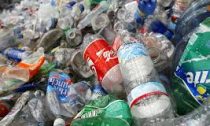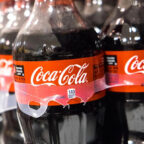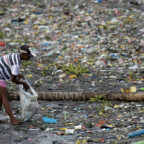
Mangrove swamps are normally buzzing with life, as multitudes of colourful crabs and other creatures scurry about on the muddy forest floor. But when marine scientist Dr Brent Newman visited Durban harbour last week, he was astonished to find not a single crab in a section of mangroves near the Bluff Yacht Club.
The reason? The biologically-rich environment has been smothered by a thick layer of plastic and other floating litter, making it impossible for crabs to burrow down into the mud.
“The mangroves were full of plastic, obliterating habitat for crabs. We could not find even one,” the Council for Scientific and Industrial Research (CSIR) scientist told a panel discussion at the University of KwaZulu-Natal (UKZN).
Marine biology lecturer Dr David Glassom said recent studies by UKZN biology students demonstrated that several species of juvenile fish off the Durban coastline were growing more slowly and dying more frequently from eating microplastics (tiny fragments of plastic washed into the ocean sea from a wide variety of land-based sources).
Plastic pollution of the sea was a comparatively recent problem, he said, spawned by the throw-away society that developed in the mid-1950s when manufacturers began to encourage people to use disposable products like paper plates and cups, plastic bags, plastic cutlery and plastic packaging material.
Now, almost 70 years later, plastic marine debris had spread to the remotest islands and isolated polar regions.
Dr Jenna Jambeck, a University of Georgia researcher who led a recent international scientific study on marine plastic pollution, estimated that 8 million tons of plastic flowed into the world’s oceans in 2010 alone.
In a study published two years ago, Jambeck ranked South Africa among the worst culprits.
In the list of 20 countries that generated the highest volumes of “mismanaged plastic waste”, South Africa came in at No 11- worse than India, the entire United States and 23 European countries.
The worst offenders were China and other Eastern nations.
In 1960, she said, plastic made up less than 1% of solid waste in municipal garbage dumps but this had increased to around 10% in countries where data was available.
In a separate study published earlier this month (JULY), Jambeck estimated that 60% of all plastics ever produced had been discarded into landfills and the wider land and sea environment.
“Without a well-designed and tailor-made management strategy for end-of-life plastics, humans are conducting a singular, uncontrolled experiment on a global scale,” she said.
Jambek believes that the mountain of plastic and other wastes will keep growing for at least 80 years, especially in Africa and other developing nations resulting in the “near permanent” contamination of the natural environment.
She estimated that 7 800 million tons of plastic resins and fibres have been produced globally since 1950 – half of this in the last 13 years.
Mark Gerrard of the Wildlands Conservation Trust said a major plastic recycling project had been set up near Pietermaritzburg to convert plastic waste into a variety of products such as school desks and chairs.
Ideally, he said, the problem should be tackled at the source by reducing the volume of disposable plastic produced or dumped in the environment. But as interim strategy, Wildlands was trying to create work for poor communities by encouraging them to collect plastic bottles and other debris for recycling.
“One of the big problems is public awareness. Portnet spends millions every year trying to clear up the mess, but after every heavy rainfall you still see football-sized fields of plastic floating around in the harbour.”
Plastics SA, the umbrella organisation representing the local plastics industry, estimates that about 293 000 tons of plastic was recycled in South Africa in 2015 – about 19% of the volume of virgin plastic polymer produced in this country in the same year.
In a media statement, Plastics SA spokesman Anton Hanekom said: “South Africa has a thriving recycling industry that creates jobs for thousands of people. Yet, it is frustrating to see that there is still not an established recycling culture in our country. We still see too much plastic ending up in landfill that could have been recycled many times over into various new products.”
However, in some provinces, up to 40% of plastic collected was scrapped or rejected by recyclers because of contamination or impurities.
“There seems to be a public perception and expectation that the recycling industry needs to save the planet, extend the supply of natural resources, provide cheaper raw materials, create sustainable jobs, fix the image of plastics littering, save landfill space, rid the country of its visible litter problem… All at no cost to anyone!”
Vice Chairman of Coastwatch KZN, Jon Marshall, added that, “as part of a network of NGOs working towards reducing the volumes of plastic entering the marine system, we support the Reduce, Reuse, Recycle principle. We are engaging with authorities at varying levels of government, in our combined effort to step up to the worldwide effort to reverse the worldwide use of plastics, which so adversely affect our marine environment. Although we support and are part of the reactive clean-ups which occur on a regular basis, our focus is more on proactively reducing land-based waste.”















Social Profiles